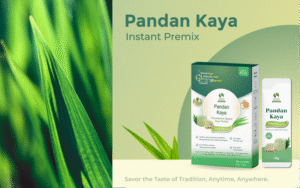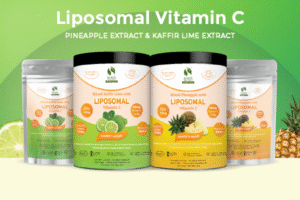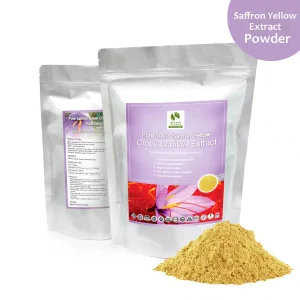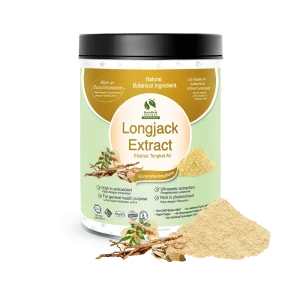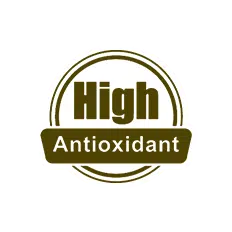Overview
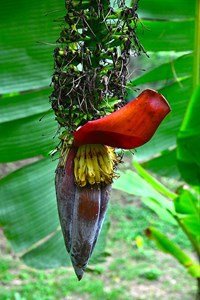
The banana (
Musa spp., Musaceae) plant is large and tree-like, growing out of an underground rhizome and producing a tall pseudostem (false stem) that can grow up to six meters (roughly 20 feet) high. This pseudostem is the basal portion of the plant’s oblong, dark green leaves, which can grow up to 3.5 meters (11.5 feet) long and form a rosette at the top of the plant. The banana fruits come from white or yellowish-white flowers protected by purplish bracts, which grow in clusters. Each pseudostem produces one bunch of fruit; after harvest, the plants are cut down to the ground in commercial farming to encourage new growth from the rhizome. This growth cycle lasts approximately six months. Botanically speaking, the banana plant is considered an herbaceous plant, not a tree, and banana fruits are considered berries.
1,2
The Musaceae family currently contains three genera,
Musa,
Ensete, and
Musella, and the genus
Musa contains approximately 65 known species.
2 Musa species include wild bananas, domesticated bananas, and plantains (
Musa ×
paradisiaca). The common name “plantain” also refers to plants in the genus
Plantago (Plantaginaceae), which are not related to edible bananas.
Most commercial banana varieties are hybrids of
Musa acuminata or
M.
balbisiana. The most popular exported variety, the Cavendish banana, is a cultivar of
M.
acuminata, the wild banana, which humans domesticated around 10,000 years ago in Southeast Asia in the area that is now Malaysia.
1,2 From there, banana cultivation spread through India, where bananas were recorded by chroniclers accompanying Alexander the Great (356–323 BCE) and were then exported to Greece and Rome. Bananas reached the Western hemisphere as a result of European colonization in the 15th and 16th centuries and became popular in North America starting in the 19th century.
1
Though wild bananas can spread by seed, these large, hard seeds have been bred out of modern commercial varieties, which reproduce clonally through the rhizome. This lack of genetic variation makes bananas highly susceptible to disease and requires strict land management.
3
History, Traditional Uses, and Trade
Taxonomist and botanist Carl Linnaeus (1707–1778) classified banana species as
Musa ×
paradisiaca and
M. ×
sapientum in the 18th century, with the genus named in honor of Antonius Musa (63 BCE–14 CE), a Greek botanist and physician to Roman Emperor Augustus.
3,4 However, in 1955, further studies of the plant resulted the development of a new classification system based on the unique genetic traits of wild bananas and their cultivars. Currently, scientists agree that “
Musa spp.” can serve as a catch-all term for edible bananas.
Traditional Uses: Banana Fruit
Bananas have been consumed as food and used in traditional medicine systems for approximately 10,000 years. Ancient peoples used all parts of the banana plant to heal a variety of conditions. In India, banana appears in ancient treatises and epics including the
Ramayana (ca. 2000 BCE),
Arthashastra (ca. 250 BCE), and
Cilappatikaram (ca. 500 CE).
4 The ripe fruit was used for conditions including inflammation, arthritis, hypertension, cough, and bronchitis. In Iranian traditional medicine, bananas were prescribed for depression and stress conditions. Because bananas are soft and easy to digest, they are a popular food for sick children and babies to maintain adequate nutrition.

Banana also appears in ethnoveterinary medicine in India and Pakistan, where green (unripe) bananas were used to treat diarrhea and for injured hooves. Because green bananas are astringent and have high levels of tannins, they were often used for similar indications in humans, including dysentery and excess menstruation. In Brazil, green bananas are used for wound healing and in cancer treatment.
3
Traditional Uses: Other Banana Parts
In Brazil, all parts of the banana plant are used in traditional medicine. Peels are applied as a poultice for cuts, swelling, and burns. Banana peels are also used for other skin conditions, including warts and bug bites. The banana pseudostem is juiced, sweetened, and administered both orally for diarrhea and topically to wash ulcers, while an infusion of the banana flower is used as an eye wash. Banana leaf is used in giardiasis (a gastrointestinal infection caused by a parasitic infection, often connected to unsanitary water), as is the fruit.
3 The use of banana peels to treat warts has been scientifically tested: A fresh piece of banana peel placed continuously against a plantar wart every day for six weeks was observed to remove the wart in a case study.
5
Among tribal peoples in northeastern India, banana pseudostem juice also is used for diarrhea and given to children to treat ulcers and canker sores. A decoction of plants containing
M.
paradisiaca pseudostem juice,
Stereospermum chelonoides (Bigoniaceae) root, crown flower (
Calotropis gigantea, Apocynaceae) latex, and black pepper (
Piper nigrum, Piperaceae) is used in the treatment of snakebites. Banana leaf juice is used in the treatment of fresh wounds, cuts, and insect bites.
6 Banana leaves also are used in cooking to wrap food for steaming or roasting.
Commercial Uses: Banana Fruit
Bananas are a popular fruit and a leading crop in agriculture and trade. Global banana production from 2017 to 2019 was an estimated 116 million tons, worth approximately $31 billion. The top producers of bananas for the global market are Brazil, the Philippines, India, and China. Much of this production consists of local varieties that are consumed domestically. The Cavendish cultivar accounts for 40%–50% of global production and virtually all exports due to its high yield, short maturity cycle, and resilience to travel. Latin America and the Caribbean provide most of the world’s exported Cavendish banana crop.
7
Recently, banana crops have been under threat of extreme weather patterns and banana fusarium wilt, a fungal disease caused by
Fusarium oxysporum. This fungus, which has impacted banana plantations since the late 19th century, currently has no known effective eradication method and can cause a total yield loss in affected plants. Fusarium wilt has been confirmed in 17 countries, mostly in Southeast Asia. However, in August 2019, it was confirmed for the first time on banana plantations in La Guajira, Colombia. The impact of this fungus in the countries that produce the most exported banana crops is likely to include loss of income for producers and increased prices for consumers.
7
Commercial banana production has a history involving corporate greed, labor exploitation, market manipulation, and trade wars. Large conglomerates have created controversy by reportedly using child labor, bribing government officials, and using violence to maintain monopolies in Central American banana-producing countries such as Costa Rica, Ecuador, Guatemala, and Honduras in the early-to-mid 20th century. The term “banana republic” comes from this part of history and refers to these countries’ dependence on banana production and foreign capital.
8,9
Commercial Uses: Other Banana Parts
Banana fruit is the primary commercial product of the plant and harvesting it requires cutting down the entire plant. This process can be wasteful, so other commercial uses for the normally discarded plant parts are being investigated.
Banana peels have been used as livestock fodder and composted into organic fertilizer. Research on converting banana peels into ethanol is in early stages of development, and the peels may be used as an adsorbent for water purification systems. Banana peel also contains many beneficial phytochemicals that can be extracted for use in consumer products for health and wellness.
3
Banana leaves traditionally have been used to bind wounds, and this could become more widespread in areas with unreliable access to commercial bandages. Sterilized banana leaves produced favorable outcomes in simulated wound healing trials and have the added advantage of not sticking to a person’s skin.
10 In addition, banana stems contain cellulose, which, with further research and refinement, could be extracted and used in the production of bandages and consumer packaging.
11
Phytochemicals and Constituents
Banana fruit contains high amounts of carotenoids and fiber as well as essential minerals such as potassium. Potassium is an electrolyte that helps the body flush out excess sodium through the urine and eases tension in blood vessel walls. For this reason, bananas can be a functional food in the diets of those who are at risk for cardiovascular disease (CVD) or who become dehydrated through diarrhea or vomiting.
12
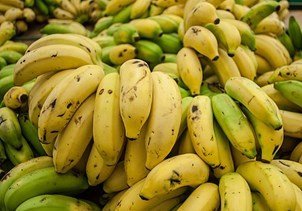
Carotenoids, the yellow-orange pigments that are found in many plants, have high antioxidant activity. The anti-inflammatory properties of carotenoids are associated with strengthening the immune system and decreasing the risk of developing degenerative diseases such as cancer, CVD, cataracts, and macular degeneration.
3 The carotenoids in banana, including alpha-carotene, beta-carotene, and beta-cryptoxanthin, are precursors of vitamin A, which is vital in the development and maintenance of healthy vision. Scientists in Australia are currently developing a variety of banana with higher levels of provitamin A compounds and are field-testing this new variety in Uganda, where bananas are a dietary staple. The goal is to prevent childhood malnutrition and deaths from vitamin A deficiency, which affects an estimated 38% of children between six months and five years old in Uganda.
13
The fiber in banana fruit is known as “resistant starch” because it resists digestion in the small intestine. Instead, it ferments in the colon. This promotes gut health by feeding the beneficial gut flora and producing short-chain fatty acids that may play a role in the prevention of digestive disorders such as Crohn’s disease and ulcerative colitis. This slowly digested fiber also means that, despite the fruit’s overall high sugar content, eating a banana does not produce a sharp rise in blood sugar.
12 This is why bananas fall somewhere in the low to medium range on the glycemic index, which is an important decision-making tool for diabetes management.
14
Selected Compounds Found in Banana3,4
| Compound Type |
Compounds |
Plant Part |
Activities |
| Biogenic amines |
Dopamine, norepinephrine, serotonin |
Fruit, peel |
Neurotransmitter |
| Flavonoids |
Catechin, epicatechin, gallocatechin, proanthocyanidins, quercetin |
Fruit, peel, leaf, flowers |
Anti-inflammatory, antioxidant, cytotoxic |
| Phenolic acids and phenolics |
Caffeic acid, ellagic acid, pyrogallol, vanillic acid |
Fruit, peel, leaf |
Anti-inflammatory, antioxidant, cytotoxic, antitumor |
| Sterols |
Beta-sitosterol, campesterol |
Fruit, peel |
Anti-inflammatory, reduces cholesterol |
Modern Research
Past research on banana has been done largely in vitro and in animal models. However, more human clinical trials are being conducted, though these trials are often small. Research on banana has been conducted on almost all of its different parts, including the ripe fruit, unripe fruit, leaf, and stem.
Antimicrobial Activities
Banana plants contain high amounts of beneficial phytochemicals with antibacterial activity. Ethanolic and methanolic extracts of banana leaf and pseudostem showed strong activity against Gram-positive bacteria strains including
Bacillus cereus,
Micrococcus luteus,
Staphylococcus aureus, and
Enterococcus faecalis. However, these ethanolic and methanolic extracts were less effective against Gram-negative strains, and aqueous extracts were the least effective against all strains.
6
Cytotoxic and Antitumor Activities
In cell line and animal models, banana extracts have shown cytotoxic and antitumor activities. Extracts of banana peel and fruit pulp increased apoptosis (normal, pre-programmed cell death) and cytotoxicity in breast cancer cell lines, while extracts of unripe banana peel inhibited cell proliferation in colon cancer cells. Cervical cancer cell lines also responded with increased apoptosis to extracts of banana flower, pseudostem, leaf, peel, green peel, and pulp. In mice, aqueous banana ripe fruit extract and a pseudostem exudate prolonged survival and reduced tumor development in breast cancer, while green banana flour supplementation decreased the number of colon cancer biomarkers.
4
Green Bananas
Because unripe bananas are high in tannins and astringent in taste, they often are processed into a derivative product, usually a powdered “flour,” for ease of consumption. This flour tends to be higher in resistant starch than plain fruit pulp. Green bananas are higher in resistant starch than ripe bananas, and consumption of green bananas is linked to the prevention of intestinal diseases, reduced blood cholesterol levels, increased synthesis of B-complex vitamins and mineral absorption, and improved immune response.
15
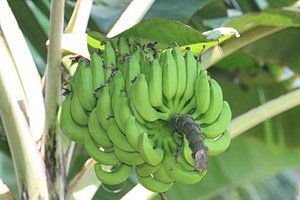
In children, studies have correlated green banana pulp supplementation with improvement in both diarrhea and constipation outcomes. In healthy adults, studies have shown that green banana pulp and flour increased feelings of satiety and helped maintained glucose homeostasis. In addition, green banana supplementation has shown promise for use in people with type 2 diabetes mellitus or who are at risk of developing it. In adults with type 2 diabetes and in overweight women, green banana flour supplementation was associated with reduced body weight, improved body composition, and decreased lipid profiles and inflammatory parameters.
15 In a 24-week study of middle-aged subjects with pre-diabetes, the active group who received nutritional support and consumed green banana fruit reported a reduction in HbA1c levels, fasting glucose, diastolic blood pressure, body weight, and waist and hip circumferences and an increase in lean mass percentage compared to those who received only nutritional support. A randomized, double-blind clinical trial found that women who consumed a beverage made from green banana flour and cocoa (
Theobroma cacao, Malvaceae) for six weeks had a reduced waist circumference and body fat percentage compared to baseline.
16
Exercise Support
Banana fruit’s slow-digesting fiber, high sugar and carbohydrate content, and electrolytes like potassium, could aid exercise performance and recovery. Trained cyclists who consumed either a banana or a sports drink showed similar levels of blood glucose, performance metrics, liver glutathione (an antioxidant) production, inflammation, and oxidative stress. However, those who consumed a banana showed higher levels of dopamine production, and bananas generally contain more beneficial vitamins and minerals than sports drinks do.
17 In another study of cyclists, subjects who consumed either a banana or a pear (
Pyrus spp., Rosaceae) achieved faster performance times than when they drank only water, with improvements of 5% and 3.3%, respectively. The authors concluded that banana ingestion improved performance, attenuated fatty acid use and oxidation, and contributed unique phenolics that improved antioxidant capacity.
18
Consumer Considerations
Bananas continue to ripen after harvest. As they do, the fruit’s sugar content increases and the flesh softens. Underripe bananas have green peels that change to yellow, then develop brown spots that spread until the overripe fruit is completely dark. Consumers should use these visual cues to choose bananas according to when they plan to eat them.
Banana growers historically have exploited labor, and market pressure to maintain low prices can lead to inequity between harvesters and marketers. The health of farmers is further endangered by exposure to pesticides, which are used extensively in banana cultivation.
19 Therefore, consumers should consider purchasing organic bananas. Third-party initiatives such as Fairtrade International are working toward fair compensation of workers, protection of their rights, and representation.
20
Bananas are cultivated widely in tropical climates, but their labor- and pesticide-intensive cultivation and susceptibility to disease can cause long-term sustainability issues. In addition, deforestation of rainforest to accommodate banana plantations threatens the health of the rainforest and creates vulnerabilities to climate change. Careful conservation of groundcover, nearby waterways, and the surrounding landscape can improve the overall productivity and longevity of banana plants as well as help prevent against climate catastrophes.
21
Nutrient Profile
Per 1 banana fruit [approx. 115 g]22
Macronutrients:
113 calories
1.4 g protein
26.4 g carbohydrates
0.3 g fat
Secondary Metabolites:
Very good source of:
Vitamin C: 14.1 mg (15.7% DV)
Vitamin B
6: 0.24 mg (14.1% DV)
Manganese: 0.3 mg (13% DV)
Dietary Fiber: 3.3 g (11% DV)
Good source of:
Potassium: 375 mg (8% DV)
Magnesium: 32.2 mg (7.7% DV)
Vitamin B
2 (Riboflavin): 0.1 mg (7.7% DV)
Vitamin B
1 (Thiamin): 0.06 mg (5% DV)
Also provides:
Vitamin B
3 (Niacin): 0.76 mg (4.8% DV)
Vitamin B
9 (Folate): 16.1 mcg (4% DV)
Iron: 0.4 mg (2.2% DV)
Phosphorus: 25.3 mg (2% DV)
Trace amounts:
Vitamin E: 0.1 mg (0.7% DV)
Vitamin A: 3.8 mcg (0.4% DV)
Vitamin K: 0.12 mcg (0.1% DV)
DV = Daily Value as established by the US Food and Drug Administration, based on a 2,000-calorie diet.
Recipe: Chocolate Chip Banana Bread
Courtesy of Kathee Bauman
Ingredients:
- 2 cups all-purpose flour
- 1 cup white sugar
- 1 teaspoon baking powder
- 1/2 teaspoon baking soda
- 1 teaspoon salt
- 1 cup mashed ripe bananas (approximately 2-3 bananas)
- 1/2 cup (1 stick) unsalted butter, at room temperature
- 2 eggs, at room temperature
- 1 cup mini semisweet chocolate chips
- 1/2 cup of chopped nuts (optional)
Directions:
- Heat oven to 350°F. Grease a loaf pan with baking spray.
- Combine dry ingredients (flour through salt) in a large bowl and whisk to combine. Add remaining ingredients except chocolate chips and nuts to the bowl and blend with a hand mixer on medium speed until smooth. Stir in chocolate chips and nuts (if using).
- Pour into prepared loaf pan and bake for 55–60 minutes. Bread is done when a toothpick inserted in the thickest part of the loaf comes out dry or with a few moist crumbs attached.
- Let loaf cool before slicing.
|
Image credits (top to bottom):
Banana flower by
Tris T7
Watercolor of a bunch of bananas in Suriname, painted by Louise von Panhuys (1812)
Green and yellow banana bunches by
Wilfredor
Green bananas on the stem by
Ch Maheswara Raju
References
- Encyclopedia Britannica. Available at: www.britannica.com/plant/banana-plant. Accessed January 12, 2022.
- Mathew NS, Negi PS. Traditional uses, phytochemistry and pharmacology of wild banana (Musa acuminata Colla): A review. J Ethnopharmacol. 2017;196:124-140.
- Pereira A, Maraschin M. Banana (Musa spp) from peel to pulp: Ethnopharmacology, source of bioactive compounds and its relevance for human health. J Ethnopharmacol. 2015;160:149-163.
- Mondal A, Banerjee S, Bose S, et al. Cancer preventive and therapeutic potential of banana and its bioactive constituents: A systematic, comprehensive, and mechanistic review. Front Oncol. 2021;11:697143.
- Warszawer-Schvaroz L. Treatment of plantar warts with banana skin. Plastic and Reconstructive Surgery. Dec 1981;68(6):975.
- Jouhneghani RS, Castro AHF, Panda SK, Swennen R, Luyten W. Antimicrobial activity of selected banana cultivars against important human pathogens, including candida biofilm. Foods. 2020;9(4):435.
- Food and Agriculture Organization of the United Nations. Banana Market Review: February 2020 Snapshot. February 2020.
- Forero J. In Ecuador’s Banana Fields, Child Labor Is Key to Profits. The New York Times. July 13, 2002. Available at: www.nytimes.com/2002/07/13/world/in-ecuador-s-banana-fields-child-labor-is-key-to-profits.html. Accessed May 10, 2022.
- Bucheli M. Bananas and Business: The United Fruit Company in Colombia, 1988–2000. New York, NY: NYU Press; 2005.
- Hoetzenecker W, Guenova E, Moehrle M. Banana leaves: An alternative wound dressing material? Expert Rev Dermatol. 2013;8(5):439-440.
- Nascimento REA, Monte J, Cadima M, Alves VD, Neves LA. Rendering banana plant residues into a potentially commercial byproduct by doping cellulose films with phenolic compounds. Polymers (Basel). 2021;13(5):843.
- The Nutrition Source. Harvard School of Public Health. Available at: www.hsph.harvard.edu/nutritionsource/food-features/bananas/. Accessed April 20, 2022.
- Paul JY, Khanna H, Kleidon J, et al. Golden bananas in the field: Elevated fruit pro-vitamin A from the expression of a single banana transgene. Plant Biotechnol J. 2017;15(4):520-532.
- West H. How Bananas Affect Diabetes and Blood Sugar Levels. Healthline website. August 6, 2021. Available at: www.healthline.com/nutrition/bananas-diabetes. Accessed May 4, 2022.
- Falcomer AL, Riquette RFR, de Lima BR, Ginani VC, Zandonadi RP. Health benefits of green banana consumption: A systematic review. Nutrients. 2019;11(6):1222.
- de Olivera Lomeu FLR, Vieira CR, Lucia FD, Veiga SMOM, Martino HSD, Silva RR. Cocoa and unripe banana flour beverages improve anthropometric and biochemical markers in overweight women: A randomised double-blind study. Int J Vitam Nutr Res. 2021 Jun;91(3-4):325-334.
- Nieman DC, Gillitt ND, Henson DA, et al. Bananas as an energy source during exercise: A metabolomics approach. PLoS One. 2012;7(5):e37479.
- Nieman DC, Gillitt ND, Sha W, et all. Metabolomics-based analysis of banana and pear ingestion on exercise performance and recovery. J Proteome Res. 2015;14(12):5367-5377.
- Hutter HP, Poteser M, Lemmerer K, et al. Health symptoms related to pesticide use in farmers and laborers of ecological and conventional banana plantations in Ecuador. Int J Environ Res Public Health. 2021 Feb;18(3):1126.
- Fairtrade International website. Available at: www.fairtrade.net/product/bananas. Accessed May 4, 2022.
- How Are More Sustainable Bananas Grown? Rainforest Alliance website. June 25, 2018. Available at: www.rainforest-alliance.org/insights/how-are-more-sustainable-bananas-grown/. Accessed May 10, 2022.
- Bananas, ripe and slightly ripe, raw. US Department of Agriculture website. Available at: https://fdc.nal.usda.gov/fdc-app.html#/food-details/1105314/nutrients. Accessed May 4, 2022.
 The banana (Musa spp., Musaceae) plant is large and tree-like, growing out of an underground rhizome and producing a tall pseudostem (false stem) that can grow up to six meters (roughly 20 feet) high. This pseudostem is the basal portion of the plant’s oblong, dark green leaves, which can grow up to 3.5 meters (11.5 feet) long and form a rosette at the top of the plant. The banana fruits come from white or yellowish-white flowers protected by purplish bracts, which grow in clusters. Each pseudostem produces one bunch of fruit; after harvest, the plants are cut down to the ground in commercial farming to encourage new growth from the rhizome. This growth cycle lasts approximately six months. Botanically speaking, the banana plant is considered an herbaceous plant, not a tree, and banana fruits are considered berries.1,2
The Musaceae family currently contains three genera, Musa, Ensete, and Musella, and the genus Musa contains approximately 65 known species.2 Musa species include wild bananas, domesticated bananas, and plantains (Musa × paradisiaca). The common name “plantain” also refers to plants in the genus Plantago (Plantaginaceae), which are not related to edible bananas.
Most commercial banana varieties are hybrids of Musa acuminata or M. balbisiana. The most popular exported variety, the Cavendish banana, is a cultivar of M. acuminata, the wild banana, which humans domesticated around 10,000 years ago in Southeast Asia in the area that is now Malaysia.1,2 From there, banana cultivation spread through India, where bananas were recorded by chroniclers accompanying Alexander the Great (356–323 BCE) and were then exported to Greece and Rome. Bananas reached the Western hemisphere as a result of European colonization in the 15th and 16th centuries and became popular in North America starting in the 19th century.1
Though wild bananas can spread by seed, these large, hard seeds have been bred out of modern commercial varieties, which reproduce clonally through the rhizome. This lack of genetic variation makes bananas highly susceptible to disease and requires strict land management.3
History, Traditional Uses, and Trade
Taxonomist and botanist Carl Linnaeus (1707–1778) classified banana species as Musa × paradisiaca and M. × sapientum in the 18th century, with the genus named in honor of Antonius Musa (63 BCE–14 CE), a Greek botanist and physician to Roman Emperor Augustus.3,4 However, in 1955, further studies of the plant resulted the development of a new classification system based on the unique genetic traits of wild bananas and their cultivars. Currently, scientists agree that “Musa spp.” can serve as a catch-all term for edible bananas.
Traditional Uses: Banana Fruit
Bananas have been consumed as food and used in traditional medicine systems for approximately 10,000 years. Ancient peoples used all parts of the banana plant to heal a variety of conditions. In India, banana appears in ancient treatises and epics including the Ramayana (ca. 2000 BCE), Arthashastra (ca. 250 BCE), and Cilappatikaram (ca. 500 CE).4 The ripe fruit was used for conditions including inflammation, arthritis, hypertension, cough, and bronchitis. In Iranian traditional medicine, bananas were prescribed for depression and stress conditions. Because bananas are soft and easy to digest, they are a popular food for sick children and babies to maintain adequate nutrition.
The banana (Musa spp., Musaceae) plant is large and tree-like, growing out of an underground rhizome and producing a tall pseudostem (false stem) that can grow up to six meters (roughly 20 feet) high. This pseudostem is the basal portion of the plant’s oblong, dark green leaves, which can grow up to 3.5 meters (11.5 feet) long and form a rosette at the top of the plant. The banana fruits come from white or yellowish-white flowers protected by purplish bracts, which grow in clusters. Each pseudostem produces one bunch of fruit; after harvest, the plants are cut down to the ground in commercial farming to encourage new growth from the rhizome. This growth cycle lasts approximately six months. Botanically speaking, the banana plant is considered an herbaceous plant, not a tree, and banana fruits are considered berries.1,2
The Musaceae family currently contains three genera, Musa, Ensete, and Musella, and the genus Musa contains approximately 65 known species.2 Musa species include wild bananas, domesticated bananas, and plantains (Musa × paradisiaca). The common name “plantain” also refers to plants in the genus Plantago (Plantaginaceae), which are not related to edible bananas.
Most commercial banana varieties are hybrids of Musa acuminata or M. balbisiana. The most popular exported variety, the Cavendish banana, is a cultivar of M. acuminata, the wild banana, which humans domesticated around 10,000 years ago in Southeast Asia in the area that is now Malaysia.1,2 From there, banana cultivation spread through India, where bananas were recorded by chroniclers accompanying Alexander the Great (356–323 BCE) and were then exported to Greece and Rome. Bananas reached the Western hemisphere as a result of European colonization in the 15th and 16th centuries and became popular in North America starting in the 19th century.1
Though wild bananas can spread by seed, these large, hard seeds have been bred out of modern commercial varieties, which reproduce clonally through the rhizome. This lack of genetic variation makes bananas highly susceptible to disease and requires strict land management.3
History, Traditional Uses, and Trade
Taxonomist and botanist Carl Linnaeus (1707–1778) classified banana species as Musa × paradisiaca and M. × sapientum in the 18th century, with the genus named in honor of Antonius Musa (63 BCE–14 CE), a Greek botanist and physician to Roman Emperor Augustus.3,4 However, in 1955, further studies of the plant resulted the development of a new classification system based on the unique genetic traits of wild bananas and their cultivars. Currently, scientists agree that “Musa spp.” can serve as a catch-all term for edible bananas.
Traditional Uses: Banana Fruit
Bananas have been consumed as food and used in traditional medicine systems for approximately 10,000 years. Ancient peoples used all parts of the banana plant to heal a variety of conditions. In India, banana appears in ancient treatises and epics including the Ramayana (ca. 2000 BCE), Arthashastra (ca. 250 BCE), and Cilappatikaram (ca. 500 CE).4 The ripe fruit was used for conditions including inflammation, arthritis, hypertension, cough, and bronchitis. In Iranian traditional medicine, bananas were prescribed for depression and stress conditions. Because bananas are soft and easy to digest, they are a popular food for sick children and babies to maintain adequate nutrition.
 Banana also appears in ethnoveterinary medicine in India and Pakistan, where green (unripe) bananas were used to treat diarrhea and for injured hooves. Because green bananas are astringent and have high levels of tannins, they were often used for similar indications in humans, including dysentery and excess menstruation. In Brazil, green bananas are used for wound healing and in cancer treatment.3
Traditional Uses: Other Banana Parts
In Brazil, all parts of the banana plant are used in traditional medicine. Peels are applied as a poultice for cuts, swelling, and burns. Banana peels are also used for other skin conditions, including warts and bug bites. The banana pseudostem is juiced, sweetened, and administered both orally for diarrhea and topically to wash ulcers, while an infusion of the banana flower is used as an eye wash. Banana leaf is used in giardiasis (a gastrointestinal infection caused by a parasitic infection, often connected to unsanitary water), as is the fruit.3 The use of banana peels to treat warts has been scientifically tested: A fresh piece of banana peel placed continuously against a plantar wart every day for six weeks was observed to remove the wart in a case study.5
Among tribal peoples in northeastern India, banana pseudostem juice also is used for diarrhea and given to children to treat ulcers and canker sores. A decoction of plants containing M. paradisiaca pseudostem juice, Stereospermum chelonoides (Bigoniaceae) root, crown flower (Calotropis gigantea, Apocynaceae) latex, and black pepper (Piper nigrum, Piperaceae) is used in the treatment of snakebites. Banana leaf juice is used in the treatment of fresh wounds, cuts, and insect bites.6 Banana leaves also are used in cooking to wrap food for steaming or roasting.
Commercial Uses: Banana Fruit
Bananas are a popular fruit and a leading crop in agriculture and trade. Global banana production from 2017 to 2019 was an estimated 116 million tons, worth approximately $31 billion. The top producers of bananas for the global market are Brazil, the Philippines, India, and China. Much of this production consists of local varieties that are consumed domestically. The Cavendish cultivar accounts for 40%–50% of global production and virtually all exports due to its high yield, short maturity cycle, and resilience to travel. Latin America and the Caribbean provide most of the world’s exported Cavendish banana crop.7
Recently, banana crops have been under threat of extreme weather patterns and banana fusarium wilt, a fungal disease caused by Fusarium oxysporum. This fungus, which has impacted banana plantations since the late 19th century, currently has no known effective eradication method and can cause a total yield loss in affected plants. Fusarium wilt has been confirmed in 17 countries, mostly in Southeast Asia. However, in August 2019, it was confirmed for the first time on banana plantations in La Guajira, Colombia. The impact of this fungus in the countries that produce the most exported banana crops is likely to include loss of income for producers and increased prices for consumers.7
Commercial banana production has a history involving corporate greed, labor exploitation, market manipulation, and trade wars. Large conglomerates have created controversy by reportedly using child labor, bribing government officials, and using violence to maintain monopolies in Central American banana-producing countries such as Costa Rica, Ecuador, Guatemala, and Honduras in the early-to-mid 20th century. The term “banana republic” comes from this part of history and refers to these countries’ dependence on banana production and foreign capital.8,9
Commercial Uses: Other Banana Parts
Banana fruit is the primary commercial product of the plant and harvesting it requires cutting down the entire plant. This process can be wasteful, so other commercial uses for the normally discarded plant parts are being investigated.
Banana peels have been used as livestock fodder and composted into organic fertilizer. Research on converting banana peels into ethanol is in early stages of development, and the peels may be used as an adsorbent for water purification systems. Banana peel also contains many beneficial phytochemicals that can be extracted for use in consumer products for health and wellness.3
Banana leaves traditionally have been used to bind wounds, and this could become more widespread in areas with unreliable access to commercial bandages. Sterilized banana leaves produced favorable outcomes in simulated wound healing trials and have the added advantage of not sticking to a person’s skin.10 In addition, banana stems contain cellulose, which, with further research and refinement, could be extracted and used in the production of bandages and consumer packaging.11
Phytochemicals and Constituents
Banana fruit contains high amounts of carotenoids and fiber as well as essential minerals such as potassium. Potassium is an electrolyte that helps the body flush out excess sodium through the urine and eases tension in blood vessel walls. For this reason, bananas can be a functional food in the diets of those who are at risk for cardiovascular disease (CVD) or who become dehydrated through diarrhea or vomiting.12
Banana also appears in ethnoveterinary medicine in India and Pakistan, where green (unripe) bananas were used to treat diarrhea and for injured hooves. Because green bananas are astringent and have high levels of tannins, they were often used for similar indications in humans, including dysentery and excess menstruation. In Brazil, green bananas are used for wound healing and in cancer treatment.3
Traditional Uses: Other Banana Parts
In Brazil, all parts of the banana plant are used in traditional medicine. Peels are applied as a poultice for cuts, swelling, and burns. Banana peels are also used for other skin conditions, including warts and bug bites. The banana pseudostem is juiced, sweetened, and administered both orally for diarrhea and topically to wash ulcers, while an infusion of the banana flower is used as an eye wash. Banana leaf is used in giardiasis (a gastrointestinal infection caused by a parasitic infection, often connected to unsanitary water), as is the fruit.3 The use of banana peels to treat warts has been scientifically tested: A fresh piece of banana peel placed continuously against a plantar wart every day for six weeks was observed to remove the wart in a case study.5
Among tribal peoples in northeastern India, banana pseudostem juice also is used for diarrhea and given to children to treat ulcers and canker sores. A decoction of plants containing M. paradisiaca pseudostem juice, Stereospermum chelonoides (Bigoniaceae) root, crown flower (Calotropis gigantea, Apocynaceae) latex, and black pepper (Piper nigrum, Piperaceae) is used in the treatment of snakebites. Banana leaf juice is used in the treatment of fresh wounds, cuts, and insect bites.6 Banana leaves also are used in cooking to wrap food for steaming or roasting.
Commercial Uses: Banana Fruit
Bananas are a popular fruit and a leading crop in agriculture and trade. Global banana production from 2017 to 2019 was an estimated 116 million tons, worth approximately $31 billion. The top producers of bananas for the global market are Brazil, the Philippines, India, and China. Much of this production consists of local varieties that are consumed domestically. The Cavendish cultivar accounts for 40%–50% of global production and virtually all exports due to its high yield, short maturity cycle, and resilience to travel. Latin America and the Caribbean provide most of the world’s exported Cavendish banana crop.7
Recently, banana crops have been under threat of extreme weather patterns and banana fusarium wilt, a fungal disease caused by Fusarium oxysporum. This fungus, which has impacted banana plantations since the late 19th century, currently has no known effective eradication method and can cause a total yield loss in affected plants. Fusarium wilt has been confirmed in 17 countries, mostly in Southeast Asia. However, in August 2019, it was confirmed for the first time on banana plantations in La Guajira, Colombia. The impact of this fungus in the countries that produce the most exported banana crops is likely to include loss of income for producers and increased prices for consumers.7
Commercial banana production has a history involving corporate greed, labor exploitation, market manipulation, and trade wars. Large conglomerates have created controversy by reportedly using child labor, bribing government officials, and using violence to maintain monopolies in Central American banana-producing countries such as Costa Rica, Ecuador, Guatemala, and Honduras in the early-to-mid 20th century. The term “banana republic” comes from this part of history and refers to these countries’ dependence on banana production and foreign capital.8,9
Commercial Uses: Other Banana Parts
Banana fruit is the primary commercial product of the plant and harvesting it requires cutting down the entire plant. This process can be wasteful, so other commercial uses for the normally discarded plant parts are being investigated.
Banana peels have been used as livestock fodder and composted into organic fertilizer. Research on converting banana peels into ethanol is in early stages of development, and the peels may be used as an adsorbent for water purification systems. Banana peel also contains many beneficial phytochemicals that can be extracted for use in consumer products for health and wellness.3
Banana leaves traditionally have been used to bind wounds, and this could become more widespread in areas with unreliable access to commercial bandages. Sterilized banana leaves produced favorable outcomes in simulated wound healing trials and have the added advantage of not sticking to a person’s skin.10 In addition, banana stems contain cellulose, which, with further research and refinement, could be extracted and used in the production of bandages and consumer packaging.11
Phytochemicals and Constituents
Banana fruit contains high amounts of carotenoids and fiber as well as essential minerals such as potassium. Potassium is an electrolyte that helps the body flush out excess sodium through the urine and eases tension in blood vessel walls. For this reason, bananas can be a functional food in the diets of those who are at risk for cardiovascular disease (CVD) or who become dehydrated through diarrhea or vomiting.12
 Carotenoids, the yellow-orange pigments that are found in many plants, have high antioxidant activity. The anti-inflammatory properties of carotenoids are associated with strengthening the immune system and decreasing the risk of developing degenerative diseases such as cancer, CVD, cataracts, and macular degeneration.3 The carotenoids in banana, including alpha-carotene, beta-carotene, and beta-cryptoxanthin, are precursors of vitamin A, which is vital in the development and maintenance of healthy vision. Scientists in Australia are currently developing a variety of banana with higher levels of provitamin A compounds and are field-testing this new variety in Uganda, where bananas are a dietary staple. The goal is to prevent childhood malnutrition and deaths from vitamin A deficiency, which affects an estimated 38% of children between six months and five years old in Uganda.13
The fiber in banana fruit is known as “resistant starch” because it resists digestion in the small intestine. Instead, it ferments in the colon. This promotes gut health by feeding the beneficial gut flora and producing short-chain fatty acids that may play a role in the prevention of digestive disorders such as Crohn’s disease and ulcerative colitis. This slowly digested fiber also means that, despite the fruit’s overall high sugar content, eating a banana does not produce a sharp rise in blood sugar.12 This is why bananas fall somewhere in the low to medium range on the glycemic index, which is an important decision-making tool for diabetes management.14
Selected Compounds Found in Banana3,4
Carotenoids, the yellow-orange pigments that are found in many plants, have high antioxidant activity. The anti-inflammatory properties of carotenoids are associated with strengthening the immune system and decreasing the risk of developing degenerative diseases such as cancer, CVD, cataracts, and macular degeneration.3 The carotenoids in banana, including alpha-carotene, beta-carotene, and beta-cryptoxanthin, are precursors of vitamin A, which is vital in the development and maintenance of healthy vision. Scientists in Australia are currently developing a variety of banana with higher levels of provitamin A compounds and are field-testing this new variety in Uganda, where bananas are a dietary staple. The goal is to prevent childhood malnutrition and deaths from vitamin A deficiency, which affects an estimated 38% of children between six months and five years old in Uganda.13
The fiber in banana fruit is known as “resistant starch” because it resists digestion in the small intestine. Instead, it ferments in the colon. This promotes gut health by feeding the beneficial gut flora and producing short-chain fatty acids that may play a role in the prevention of digestive disorders such as Crohn’s disease and ulcerative colitis. This slowly digested fiber also means that, despite the fruit’s overall high sugar content, eating a banana does not produce a sharp rise in blood sugar.12 This is why bananas fall somewhere in the low to medium range on the glycemic index, which is an important decision-making tool for diabetes management.14
Selected Compounds Found in Banana3,4
 In children, studies have correlated green banana pulp supplementation with improvement in both diarrhea and constipation outcomes. In healthy adults, studies have shown that green banana pulp and flour increased feelings of satiety and helped maintained glucose homeostasis. In addition, green banana supplementation has shown promise for use in people with type 2 diabetes mellitus or who are at risk of developing it. In adults with type 2 diabetes and in overweight women, green banana flour supplementation was associated with reduced body weight, improved body composition, and decreased lipid profiles and inflammatory parameters.15 In a 24-week study of middle-aged subjects with pre-diabetes, the active group who received nutritional support and consumed green banana fruit reported a reduction in HbA1c levels, fasting glucose, diastolic blood pressure, body weight, and waist and hip circumferences and an increase in lean mass percentage compared to those who received only nutritional support. A randomized, double-blind clinical trial found that women who consumed a beverage made from green banana flour and cocoa (Theobroma cacao, Malvaceae) for six weeks had a reduced waist circumference and body fat percentage compared to baseline.16
Exercise Support
Banana fruit’s slow-digesting fiber, high sugar and carbohydrate content, and electrolytes like potassium, could aid exercise performance and recovery. Trained cyclists who consumed either a banana or a sports drink showed similar levels of blood glucose, performance metrics, liver glutathione (an antioxidant) production, inflammation, and oxidative stress. However, those who consumed a banana showed higher levels of dopamine production, and bananas generally contain more beneficial vitamins and minerals than sports drinks do.17 In another study of cyclists, subjects who consumed either a banana or a pear (Pyrus spp., Rosaceae) achieved faster performance times than when they drank only water, with improvements of 5% and 3.3%, respectively. The authors concluded that banana ingestion improved performance, attenuated fatty acid use and oxidation, and contributed unique phenolics that improved antioxidant capacity.18
Consumer Considerations
Bananas continue to ripen after harvest. As they do, the fruit’s sugar content increases and the flesh softens. Underripe bananas have green peels that change to yellow, then develop brown spots that spread until the overripe fruit is completely dark. Consumers should use these visual cues to choose bananas according to when they plan to eat them.
Banana growers historically have exploited labor, and market pressure to maintain low prices can lead to inequity between harvesters and marketers. The health of farmers is further endangered by exposure to pesticides, which are used extensively in banana cultivation.19 Therefore, consumers should consider purchasing organic bananas. Third-party initiatives such as Fairtrade International are working toward fair compensation of workers, protection of their rights, and representation.20
Bananas are cultivated widely in tropical climates, but their labor- and pesticide-intensive cultivation and susceptibility to disease can cause long-term sustainability issues. In addition, deforestation of rainforest to accommodate banana plantations threatens the health of the rainforest and creates vulnerabilities to climate change. Careful conservation of groundcover, nearby waterways, and the surrounding landscape can improve the overall productivity and longevity of banana plants as well as help prevent against climate catastrophes.21
Nutrient Profile
Per 1 banana fruit [approx. 115 g]22
Macronutrients:
113 calories
1.4 g protein
26.4 g carbohydrates
0.3 g fat
Secondary Metabolites:
Very good source of:
Vitamin C: 14.1 mg (15.7% DV)
Vitamin B6: 0.24 mg (14.1% DV)
Manganese: 0.3 mg (13% DV)
Dietary Fiber: 3.3 g (11% DV)
Good source of:
Potassium: 375 mg (8% DV)
Magnesium: 32.2 mg (7.7% DV)
Vitamin B2 (Riboflavin): 0.1 mg (7.7% DV)
Vitamin B1 (Thiamin): 0.06 mg (5% DV)
Also provides:
Vitamin B3 (Niacin): 0.76 mg (4.8% DV)
Vitamin B9 (Folate): 16.1 mcg (4% DV)
Iron: 0.4 mg (2.2% DV)
Phosphorus: 25.3 mg (2% DV)
Trace amounts:
Vitamin E: 0.1 mg (0.7% DV)
Vitamin A: 3.8 mcg (0.4% DV)
Vitamin K: 0.12 mcg (0.1% DV)
DV = Daily Value as established by the US Food and Drug Administration, based on a 2,000-calorie diet.
In children, studies have correlated green banana pulp supplementation with improvement in both diarrhea and constipation outcomes. In healthy adults, studies have shown that green banana pulp and flour increased feelings of satiety and helped maintained glucose homeostasis. In addition, green banana supplementation has shown promise for use in people with type 2 diabetes mellitus or who are at risk of developing it. In adults with type 2 diabetes and in overweight women, green banana flour supplementation was associated with reduced body weight, improved body composition, and decreased lipid profiles and inflammatory parameters.15 In a 24-week study of middle-aged subjects with pre-diabetes, the active group who received nutritional support and consumed green banana fruit reported a reduction in HbA1c levels, fasting glucose, diastolic blood pressure, body weight, and waist and hip circumferences and an increase in lean mass percentage compared to those who received only nutritional support. A randomized, double-blind clinical trial found that women who consumed a beverage made from green banana flour and cocoa (Theobroma cacao, Malvaceae) for six weeks had a reduced waist circumference and body fat percentage compared to baseline.16
Exercise Support
Banana fruit’s slow-digesting fiber, high sugar and carbohydrate content, and electrolytes like potassium, could aid exercise performance and recovery. Trained cyclists who consumed either a banana or a sports drink showed similar levels of blood glucose, performance metrics, liver glutathione (an antioxidant) production, inflammation, and oxidative stress. However, those who consumed a banana showed higher levels of dopamine production, and bananas generally contain more beneficial vitamins and minerals than sports drinks do.17 In another study of cyclists, subjects who consumed either a banana or a pear (Pyrus spp., Rosaceae) achieved faster performance times than when they drank only water, with improvements of 5% and 3.3%, respectively. The authors concluded that banana ingestion improved performance, attenuated fatty acid use and oxidation, and contributed unique phenolics that improved antioxidant capacity.18
Consumer Considerations
Bananas continue to ripen after harvest. As they do, the fruit’s sugar content increases and the flesh softens. Underripe bananas have green peels that change to yellow, then develop brown spots that spread until the overripe fruit is completely dark. Consumers should use these visual cues to choose bananas according to when they plan to eat them.
Banana growers historically have exploited labor, and market pressure to maintain low prices can lead to inequity between harvesters and marketers. The health of farmers is further endangered by exposure to pesticides, which are used extensively in banana cultivation.19 Therefore, consumers should consider purchasing organic bananas. Third-party initiatives such as Fairtrade International are working toward fair compensation of workers, protection of their rights, and representation.20
Bananas are cultivated widely in tropical climates, but their labor- and pesticide-intensive cultivation and susceptibility to disease can cause long-term sustainability issues. In addition, deforestation of rainforest to accommodate banana plantations threatens the health of the rainforest and creates vulnerabilities to climate change. Careful conservation of groundcover, nearby waterways, and the surrounding landscape can improve the overall productivity and longevity of banana plants as well as help prevent against climate catastrophes.21
Nutrient Profile
Per 1 banana fruit [approx. 115 g]22
Macronutrients:
113 calories
1.4 g protein
26.4 g carbohydrates
0.3 g fat
Secondary Metabolites:
Very good source of:
Vitamin C: 14.1 mg (15.7% DV)
Vitamin B6: 0.24 mg (14.1% DV)
Manganese: 0.3 mg (13% DV)
Dietary Fiber: 3.3 g (11% DV)
Good source of:
Potassium: 375 mg (8% DV)
Magnesium: 32.2 mg (7.7% DV)
Vitamin B2 (Riboflavin): 0.1 mg (7.7% DV)
Vitamin B1 (Thiamin): 0.06 mg (5% DV)
Also provides:
Vitamin B3 (Niacin): 0.76 mg (4.8% DV)
Vitamin B9 (Folate): 16.1 mcg (4% DV)
Iron: 0.4 mg (2.2% DV)
Phosphorus: 25.3 mg (2% DV)
Trace amounts:
Vitamin E: 0.1 mg (0.7% DV)
Vitamin A: 3.8 mcg (0.4% DV)
Vitamin K: 0.12 mcg (0.1% DV)
DV = Daily Value as established by the US Food and Drug Administration, based on a 2,000-calorie diet.
 The banana (Musa spp., Musaceae) plant is large and tree-like, growing out of an underground rhizome and producing a tall pseudostem (false stem) that can grow up to six meters (roughly 20 feet) high. This pseudostem is the basal portion of the plant’s oblong, dark green leaves, which can grow up to 3.5 meters (11.5 feet) long and form a rosette at the top of the plant. The banana fruits come from white or yellowish-white flowers protected by purplish bracts, which grow in clusters. Each pseudostem produces one bunch of fruit; after harvest, the plants are cut down to the ground in commercial farming to encourage new growth from the rhizome. This growth cycle lasts approximately six months. Botanically speaking, the banana plant is considered an herbaceous plant, not a tree, and banana fruits are considered berries.1,2
The Musaceae family currently contains three genera, Musa, Ensete, and Musella, and the genus Musa contains approximately 65 known species.2 Musa species include wild bananas, domesticated bananas, and plantains (Musa × paradisiaca). The common name “plantain” also refers to plants in the genus Plantago (Plantaginaceae), which are not related to edible bananas.
Most commercial banana varieties are hybrids of Musa acuminata or M. balbisiana. The most popular exported variety, the Cavendish banana, is a cultivar of M. acuminata, the wild banana, which humans domesticated around 10,000 years ago in Southeast Asia in the area that is now Malaysia.1,2 From there, banana cultivation spread through India, where bananas were recorded by chroniclers accompanying Alexander the Great (356–323 BCE) and were then exported to Greece and Rome. Bananas reached the Western hemisphere as a result of European colonization in the 15th and 16th centuries and became popular in North America starting in the 19th century.1
Though wild bananas can spread by seed, these large, hard seeds have been bred out of modern commercial varieties, which reproduce clonally through the rhizome. This lack of genetic variation makes bananas highly susceptible to disease and requires strict land management.3
History, Traditional Uses, and Trade
Taxonomist and botanist Carl Linnaeus (1707–1778) classified banana species as Musa × paradisiaca and M. × sapientum in the 18th century, with the genus named in honor of Antonius Musa (63 BCE–14 CE), a Greek botanist and physician to Roman Emperor Augustus.3,4 However, in 1955, further studies of the plant resulted the development of a new classification system based on the unique genetic traits of wild bananas and their cultivars. Currently, scientists agree that “Musa spp.” can serve as a catch-all term for edible bananas.
Traditional Uses: Banana Fruit
Bananas have been consumed as food and used in traditional medicine systems for approximately 10,000 years. Ancient peoples used all parts of the banana plant to heal a variety of conditions. In India, banana appears in ancient treatises and epics including the Ramayana (ca. 2000 BCE), Arthashastra (ca. 250 BCE), and Cilappatikaram (ca. 500 CE).4 The ripe fruit was used for conditions including inflammation, arthritis, hypertension, cough, and bronchitis. In Iranian traditional medicine, bananas were prescribed for depression and stress conditions. Because bananas are soft and easy to digest, they are a popular food for sick children and babies to maintain adequate nutrition.
The banana (Musa spp., Musaceae) plant is large and tree-like, growing out of an underground rhizome and producing a tall pseudostem (false stem) that can grow up to six meters (roughly 20 feet) high. This pseudostem is the basal portion of the plant’s oblong, dark green leaves, which can grow up to 3.5 meters (11.5 feet) long and form a rosette at the top of the plant. The banana fruits come from white or yellowish-white flowers protected by purplish bracts, which grow in clusters. Each pseudostem produces one bunch of fruit; after harvest, the plants are cut down to the ground in commercial farming to encourage new growth from the rhizome. This growth cycle lasts approximately six months. Botanically speaking, the banana plant is considered an herbaceous plant, not a tree, and banana fruits are considered berries.1,2
The Musaceae family currently contains three genera, Musa, Ensete, and Musella, and the genus Musa contains approximately 65 known species.2 Musa species include wild bananas, domesticated bananas, and plantains (Musa × paradisiaca). The common name “plantain” also refers to plants in the genus Plantago (Plantaginaceae), which are not related to edible bananas.
Most commercial banana varieties are hybrids of Musa acuminata or M. balbisiana. The most popular exported variety, the Cavendish banana, is a cultivar of M. acuminata, the wild banana, which humans domesticated around 10,000 years ago in Southeast Asia in the area that is now Malaysia.1,2 From there, banana cultivation spread through India, where bananas were recorded by chroniclers accompanying Alexander the Great (356–323 BCE) and were then exported to Greece and Rome. Bananas reached the Western hemisphere as a result of European colonization in the 15th and 16th centuries and became popular in North America starting in the 19th century.1
Though wild bananas can spread by seed, these large, hard seeds have been bred out of modern commercial varieties, which reproduce clonally through the rhizome. This lack of genetic variation makes bananas highly susceptible to disease and requires strict land management.3
History, Traditional Uses, and Trade
Taxonomist and botanist Carl Linnaeus (1707–1778) classified banana species as Musa × paradisiaca and M. × sapientum in the 18th century, with the genus named in honor of Antonius Musa (63 BCE–14 CE), a Greek botanist and physician to Roman Emperor Augustus.3,4 However, in 1955, further studies of the plant resulted the development of a new classification system based on the unique genetic traits of wild bananas and their cultivars. Currently, scientists agree that “Musa spp.” can serve as a catch-all term for edible bananas.
Traditional Uses: Banana Fruit
Bananas have been consumed as food and used in traditional medicine systems for approximately 10,000 years. Ancient peoples used all parts of the banana plant to heal a variety of conditions. In India, banana appears in ancient treatises and epics including the Ramayana (ca. 2000 BCE), Arthashastra (ca. 250 BCE), and Cilappatikaram (ca. 500 CE).4 The ripe fruit was used for conditions including inflammation, arthritis, hypertension, cough, and bronchitis. In Iranian traditional medicine, bananas were prescribed for depression and stress conditions. Because bananas are soft and easy to digest, they are a popular food for sick children and babies to maintain adequate nutrition.
 Banana also appears in ethnoveterinary medicine in India and Pakistan, where green (unripe) bananas were used to treat diarrhea and for injured hooves. Because green bananas are astringent and have high levels of tannins, they were often used for similar indications in humans, including dysentery and excess menstruation. In Brazil, green bananas are used for wound healing and in cancer treatment.3
Traditional Uses: Other Banana Parts
In Brazil, all parts of the banana plant are used in traditional medicine. Peels are applied as a poultice for cuts, swelling, and burns. Banana peels are also used for other skin conditions, including warts and bug bites. The banana pseudostem is juiced, sweetened, and administered both orally for diarrhea and topically to wash ulcers, while an infusion of the banana flower is used as an eye wash. Banana leaf is used in giardiasis (a gastrointestinal infection caused by a parasitic infection, often connected to unsanitary water), as is the fruit.3 The use of banana peels to treat warts has been scientifically tested: A fresh piece of banana peel placed continuously against a plantar wart every day for six weeks was observed to remove the wart in a case study.5
Among tribal peoples in northeastern India, banana pseudostem juice also is used for diarrhea and given to children to treat ulcers and canker sores. A decoction of plants containing M. paradisiaca pseudostem juice, Stereospermum chelonoides (Bigoniaceae) root, crown flower (Calotropis gigantea, Apocynaceae) latex, and black pepper (Piper nigrum, Piperaceae) is used in the treatment of snakebites. Banana leaf juice is used in the treatment of fresh wounds, cuts, and insect bites.6 Banana leaves also are used in cooking to wrap food for steaming or roasting.
Commercial Uses: Banana Fruit
Bananas are a popular fruit and a leading crop in agriculture and trade. Global banana production from 2017 to 2019 was an estimated 116 million tons, worth approximately $31 billion. The top producers of bananas for the global market are Brazil, the Philippines, India, and China. Much of this production consists of local varieties that are consumed domestically. The Cavendish cultivar accounts for 40%–50% of global production and virtually all exports due to its high yield, short maturity cycle, and resilience to travel. Latin America and the Caribbean provide most of the world’s exported Cavendish banana crop.7
Recently, banana crops have been under threat of extreme weather patterns and banana fusarium wilt, a fungal disease caused by Fusarium oxysporum. This fungus, which has impacted banana plantations since the late 19th century, currently has no known effective eradication method and can cause a total yield loss in affected plants. Fusarium wilt has been confirmed in 17 countries, mostly in Southeast Asia. However, in August 2019, it was confirmed for the first time on banana plantations in La Guajira, Colombia. The impact of this fungus in the countries that produce the most exported banana crops is likely to include loss of income for producers and increased prices for consumers.7
Commercial banana production has a history involving corporate greed, labor exploitation, market manipulation, and trade wars. Large conglomerates have created controversy by reportedly using child labor, bribing government officials, and using violence to maintain monopolies in Central American banana-producing countries such as Costa Rica, Ecuador, Guatemala, and Honduras in the early-to-mid 20th century. The term “banana republic” comes from this part of history and refers to these countries’ dependence on banana production and foreign capital.8,9
Commercial Uses: Other Banana Parts
Banana fruit is the primary commercial product of the plant and harvesting it requires cutting down the entire plant. This process can be wasteful, so other commercial uses for the normally discarded plant parts are being investigated.
Banana peels have been used as livestock fodder and composted into organic fertilizer. Research on converting banana peels into ethanol is in early stages of development, and the peels may be used as an adsorbent for water purification systems. Banana peel also contains many beneficial phytochemicals that can be extracted for use in consumer products for health and wellness.3
Banana leaves traditionally have been used to bind wounds, and this could become more widespread in areas with unreliable access to commercial bandages. Sterilized banana leaves produced favorable outcomes in simulated wound healing trials and have the added advantage of not sticking to a person’s skin.10 In addition, banana stems contain cellulose, which, with further research and refinement, could be extracted and used in the production of bandages and consumer packaging.11
Phytochemicals and Constituents
Banana fruit contains high amounts of carotenoids and fiber as well as essential minerals such as potassium. Potassium is an electrolyte that helps the body flush out excess sodium through the urine and eases tension in blood vessel walls. For this reason, bananas can be a functional food in the diets of those who are at risk for cardiovascular disease (CVD) or who become dehydrated through diarrhea or vomiting.12
Banana also appears in ethnoveterinary medicine in India and Pakistan, where green (unripe) bananas were used to treat diarrhea and for injured hooves. Because green bananas are astringent and have high levels of tannins, they were often used for similar indications in humans, including dysentery and excess menstruation. In Brazil, green bananas are used for wound healing and in cancer treatment.3
Traditional Uses: Other Banana Parts
In Brazil, all parts of the banana plant are used in traditional medicine. Peels are applied as a poultice for cuts, swelling, and burns. Banana peels are also used for other skin conditions, including warts and bug bites. The banana pseudostem is juiced, sweetened, and administered both orally for diarrhea and topically to wash ulcers, while an infusion of the banana flower is used as an eye wash. Banana leaf is used in giardiasis (a gastrointestinal infection caused by a parasitic infection, often connected to unsanitary water), as is the fruit.3 The use of banana peels to treat warts has been scientifically tested: A fresh piece of banana peel placed continuously against a plantar wart every day for six weeks was observed to remove the wart in a case study.5
Among tribal peoples in northeastern India, banana pseudostem juice also is used for diarrhea and given to children to treat ulcers and canker sores. A decoction of plants containing M. paradisiaca pseudostem juice, Stereospermum chelonoides (Bigoniaceae) root, crown flower (Calotropis gigantea, Apocynaceae) latex, and black pepper (Piper nigrum, Piperaceae) is used in the treatment of snakebites. Banana leaf juice is used in the treatment of fresh wounds, cuts, and insect bites.6 Banana leaves also are used in cooking to wrap food for steaming or roasting.
Commercial Uses: Banana Fruit
Bananas are a popular fruit and a leading crop in agriculture and trade. Global banana production from 2017 to 2019 was an estimated 116 million tons, worth approximately $31 billion. The top producers of bananas for the global market are Brazil, the Philippines, India, and China. Much of this production consists of local varieties that are consumed domestically. The Cavendish cultivar accounts for 40%–50% of global production and virtually all exports due to its high yield, short maturity cycle, and resilience to travel. Latin America and the Caribbean provide most of the world’s exported Cavendish banana crop.7
Recently, banana crops have been under threat of extreme weather patterns and banana fusarium wilt, a fungal disease caused by Fusarium oxysporum. This fungus, which has impacted banana plantations since the late 19th century, currently has no known effective eradication method and can cause a total yield loss in affected plants. Fusarium wilt has been confirmed in 17 countries, mostly in Southeast Asia. However, in August 2019, it was confirmed for the first time on banana plantations in La Guajira, Colombia. The impact of this fungus in the countries that produce the most exported banana crops is likely to include loss of income for producers and increased prices for consumers.7
Commercial banana production has a history involving corporate greed, labor exploitation, market manipulation, and trade wars. Large conglomerates have created controversy by reportedly using child labor, bribing government officials, and using violence to maintain monopolies in Central American banana-producing countries such as Costa Rica, Ecuador, Guatemala, and Honduras in the early-to-mid 20th century. The term “banana republic” comes from this part of history and refers to these countries’ dependence on banana production and foreign capital.8,9
Commercial Uses: Other Banana Parts
Banana fruit is the primary commercial product of the plant and harvesting it requires cutting down the entire plant. This process can be wasteful, so other commercial uses for the normally discarded plant parts are being investigated.
Banana peels have been used as livestock fodder and composted into organic fertilizer. Research on converting banana peels into ethanol is in early stages of development, and the peels may be used as an adsorbent for water purification systems. Banana peel also contains many beneficial phytochemicals that can be extracted for use in consumer products for health and wellness.3
Banana leaves traditionally have been used to bind wounds, and this could become more widespread in areas with unreliable access to commercial bandages. Sterilized banana leaves produced favorable outcomes in simulated wound healing trials and have the added advantage of not sticking to a person’s skin.10 In addition, banana stems contain cellulose, which, with further research and refinement, could be extracted and used in the production of bandages and consumer packaging.11
Phytochemicals and Constituents
Banana fruit contains high amounts of carotenoids and fiber as well as essential minerals such as potassium. Potassium is an electrolyte that helps the body flush out excess sodium through the urine and eases tension in blood vessel walls. For this reason, bananas can be a functional food in the diets of those who are at risk for cardiovascular disease (CVD) or who become dehydrated through diarrhea or vomiting.12
 Carotenoids, the yellow-orange pigments that are found in many plants, have high antioxidant activity. The anti-inflammatory properties of carotenoids are associated with strengthening the immune system and decreasing the risk of developing degenerative diseases such as cancer, CVD, cataracts, and macular degeneration.3 The carotenoids in banana, including alpha-carotene, beta-carotene, and beta-cryptoxanthin, are precursors of vitamin A, which is vital in the development and maintenance of healthy vision. Scientists in Australia are currently developing a variety of banana with higher levels of provitamin A compounds and are field-testing this new variety in Uganda, where bananas are a dietary staple. The goal is to prevent childhood malnutrition and deaths from vitamin A deficiency, which affects an estimated 38% of children between six months and five years old in Uganda.13
The fiber in banana fruit is known as “resistant starch” because it resists digestion in the small intestine. Instead, it ferments in the colon. This promotes gut health by feeding the beneficial gut flora and producing short-chain fatty acids that may play a role in the prevention of digestive disorders such as Crohn’s disease and ulcerative colitis. This slowly digested fiber also means that, despite the fruit’s overall high sugar content, eating a banana does not produce a sharp rise in blood sugar.12 This is why bananas fall somewhere in the low to medium range on the glycemic index, which is an important decision-making tool for diabetes management.14
Selected Compounds Found in Banana3,4
Carotenoids, the yellow-orange pigments that are found in many plants, have high antioxidant activity. The anti-inflammatory properties of carotenoids are associated with strengthening the immune system and decreasing the risk of developing degenerative diseases such as cancer, CVD, cataracts, and macular degeneration.3 The carotenoids in banana, including alpha-carotene, beta-carotene, and beta-cryptoxanthin, are precursors of vitamin A, which is vital in the development and maintenance of healthy vision. Scientists in Australia are currently developing a variety of banana with higher levels of provitamin A compounds and are field-testing this new variety in Uganda, where bananas are a dietary staple. The goal is to prevent childhood malnutrition and deaths from vitamin A deficiency, which affects an estimated 38% of children between six months and five years old in Uganda.13
The fiber in banana fruit is known as “resistant starch” because it resists digestion in the small intestine. Instead, it ferments in the colon. This promotes gut health by feeding the beneficial gut flora and producing short-chain fatty acids that may play a role in the prevention of digestive disorders such as Crohn’s disease and ulcerative colitis. This slowly digested fiber also means that, despite the fruit’s overall high sugar content, eating a banana does not produce a sharp rise in blood sugar.12 This is why bananas fall somewhere in the low to medium range on the glycemic index, which is an important decision-making tool for diabetes management.14
Selected Compounds Found in Banana3,4
 In children, studies have correlated green banana pulp supplementation with improvement in both diarrhea and constipation outcomes. In healthy adults, studies have shown that green banana pulp and flour increased feelings of satiety and helped maintained glucose homeostasis. In addition, green banana supplementation has shown promise for use in people with type 2 diabetes mellitus or who are at risk of developing it. In adults with type 2 diabetes and in overweight women, green banana flour supplementation was associated with reduced body weight, improved body composition, and decreased lipid profiles and inflammatory parameters.15 In a 24-week study of middle-aged subjects with pre-diabetes, the active group who received nutritional support and consumed green banana fruit reported a reduction in HbA1c levels, fasting glucose, diastolic blood pressure, body weight, and waist and hip circumferences and an increase in lean mass percentage compared to those who received only nutritional support. A randomized, double-blind clinical trial found that women who consumed a beverage made from green banana flour and cocoa (Theobroma cacao, Malvaceae) for six weeks had a reduced waist circumference and body fat percentage compared to baseline.16
Exercise Support
Banana fruit’s slow-digesting fiber, high sugar and carbohydrate content, and electrolytes like potassium, could aid exercise performance and recovery. Trained cyclists who consumed either a banana or a sports drink showed similar levels of blood glucose, performance metrics, liver glutathione (an antioxidant) production, inflammation, and oxidative stress. However, those who consumed a banana showed higher levels of dopamine production, and bananas generally contain more beneficial vitamins and minerals than sports drinks do.17 In another study of cyclists, subjects who consumed either a banana or a pear (Pyrus spp., Rosaceae) achieved faster performance times than when they drank only water, with improvements of 5% and 3.3%, respectively. The authors concluded that banana ingestion improved performance, attenuated fatty acid use and oxidation, and contributed unique phenolics that improved antioxidant capacity.18
Consumer Considerations
Bananas continue to ripen after harvest. As they do, the fruit’s sugar content increases and the flesh softens. Underripe bananas have green peels that change to yellow, then develop brown spots that spread until the overripe fruit is completely dark. Consumers should use these visual cues to choose bananas according to when they plan to eat them.
Banana growers historically have exploited labor, and market pressure to maintain low prices can lead to inequity between harvesters and marketers. The health of farmers is further endangered by exposure to pesticides, which are used extensively in banana cultivation.19 Therefore, consumers should consider purchasing organic bananas. Third-party initiatives such as Fairtrade International are working toward fair compensation of workers, protection of their rights, and representation.20
Bananas are cultivated widely in tropical climates, but their labor- and pesticide-intensive cultivation and susceptibility to disease can cause long-term sustainability issues. In addition, deforestation of rainforest to accommodate banana plantations threatens the health of the rainforest and creates vulnerabilities to climate change. Careful conservation of groundcover, nearby waterways, and the surrounding landscape can improve the overall productivity and longevity of banana plants as well as help prevent against climate catastrophes.21
Nutrient Profile
Per 1 banana fruit [approx. 115 g]22
Macronutrients:
113 calories
1.4 g protein
26.4 g carbohydrates
0.3 g fat
Secondary Metabolites:
Very good source of:
Vitamin C: 14.1 mg (15.7% DV)
Vitamin B6: 0.24 mg (14.1% DV)
Manganese: 0.3 mg (13% DV)
Dietary Fiber: 3.3 g (11% DV)
Good source of:
Potassium: 375 mg (8% DV)
Magnesium: 32.2 mg (7.7% DV)
Vitamin B2 (Riboflavin): 0.1 mg (7.7% DV)
Vitamin B1 (Thiamin): 0.06 mg (5% DV)
Also provides:
Vitamin B3 (Niacin): 0.76 mg (4.8% DV)
Vitamin B9 (Folate): 16.1 mcg (4% DV)
Iron: 0.4 mg (2.2% DV)
Phosphorus: 25.3 mg (2% DV)
Trace amounts:
Vitamin E: 0.1 mg (0.7% DV)
Vitamin A: 3.8 mcg (0.4% DV)
Vitamin K: 0.12 mcg (0.1% DV)
DV = Daily Value as established by the US Food and Drug Administration, based on a 2,000-calorie diet.
In children, studies have correlated green banana pulp supplementation with improvement in both diarrhea and constipation outcomes. In healthy adults, studies have shown that green banana pulp and flour increased feelings of satiety and helped maintained glucose homeostasis. In addition, green banana supplementation has shown promise for use in people with type 2 diabetes mellitus or who are at risk of developing it. In adults with type 2 diabetes and in overweight women, green banana flour supplementation was associated with reduced body weight, improved body composition, and decreased lipid profiles and inflammatory parameters.15 In a 24-week study of middle-aged subjects with pre-diabetes, the active group who received nutritional support and consumed green banana fruit reported a reduction in HbA1c levels, fasting glucose, diastolic blood pressure, body weight, and waist and hip circumferences and an increase in lean mass percentage compared to those who received only nutritional support. A randomized, double-blind clinical trial found that women who consumed a beverage made from green banana flour and cocoa (Theobroma cacao, Malvaceae) for six weeks had a reduced waist circumference and body fat percentage compared to baseline.16
Exercise Support
Banana fruit’s slow-digesting fiber, high sugar and carbohydrate content, and electrolytes like potassium, could aid exercise performance and recovery. Trained cyclists who consumed either a banana or a sports drink showed similar levels of blood glucose, performance metrics, liver glutathione (an antioxidant) production, inflammation, and oxidative stress. However, those who consumed a banana showed higher levels of dopamine production, and bananas generally contain more beneficial vitamins and minerals than sports drinks do.17 In another study of cyclists, subjects who consumed either a banana or a pear (Pyrus spp., Rosaceae) achieved faster performance times than when they drank only water, with improvements of 5% and 3.3%, respectively. The authors concluded that banana ingestion improved performance, attenuated fatty acid use and oxidation, and contributed unique phenolics that improved antioxidant capacity.18
Consumer Considerations
Bananas continue to ripen after harvest. As they do, the fruit’s sugar content increases and the flesh softens. Underripe bananas have green peels that change to yellow, then develop brown spots that spread until the overripe fruit is completely dark. Consumers should use these visual cues to choose bananas according to when they plan to eat them.
Banana growers historically have exploited labor, and market pressure to maintain low prices can lead to inequity between harvesters and marketers. The health of farmers is further endangered by exposure to pesticides, which are used extensively in banana cultivation.19 Therefore, consumers should consider purchasing organic bananas. Third-party initiatives such as Fairtrade International are working toward fair compensation of workers, protection of their rights, and representation.20
Bananas are cultivated widely in tropical climates, but their labor- and pesticide-intensive cultivation and susceptibility to disease can cause long-term sustainability issues. In addition, deforestation of rainforest to accommodate banana plantations threatens the health of the rainforest and creates vulnerabilities to climate change. Careful conservation of groundcover, nearby waterways, and the surrounding landscape can improve the overall productivity and longevity of banana plants as well as help prevent against climate catastrophes.21
Nutrient Profile
Per 1 banana fruit [approx. 115 g]22
Macronutrients:
113 calories
1.4 g protein
26.4 g carbohydrates
0.3 g fat
Secondary Metabolites:
Very good source of:
Vitamin C: 14.1 mg (15.7% DV)
Vitamin B6: 0.24 mg (14.1% DV)
Manganese: 0.3 mg (13% DV)
Dietary Fiber: 3.3 g (11% DV)
Good source of:
Potassium: 375 mg (8% DV)
Magnesium: 32.2 mg (7.7% DV)
Vitamin B2 (Riboflavin): 0.1 mg (7.7% DV)
Vitamin B1 (Thiamin): 0.06 mg (5% DV)
Also provides:
Vitamin B3 (Niacin): 0.76 mg (4.8% DV)
Vitamin B9 (Folate): 16.1 mcg (4% DV)
Iron: 0.4 mg (2.2% DV)
Phosphorus: 25.3 mg (2% DV)
Trace amounts:
Vitamin E: 0.1 mg (0.7% DV)
Vitamin A: 3.8 mcg (0.4% DV)
Vitamin K: 0.12 mcg (0.1% DV)
DV = Daily Value as established by the US Food and Drug Administration, based on a 2,000-calorie diet.


